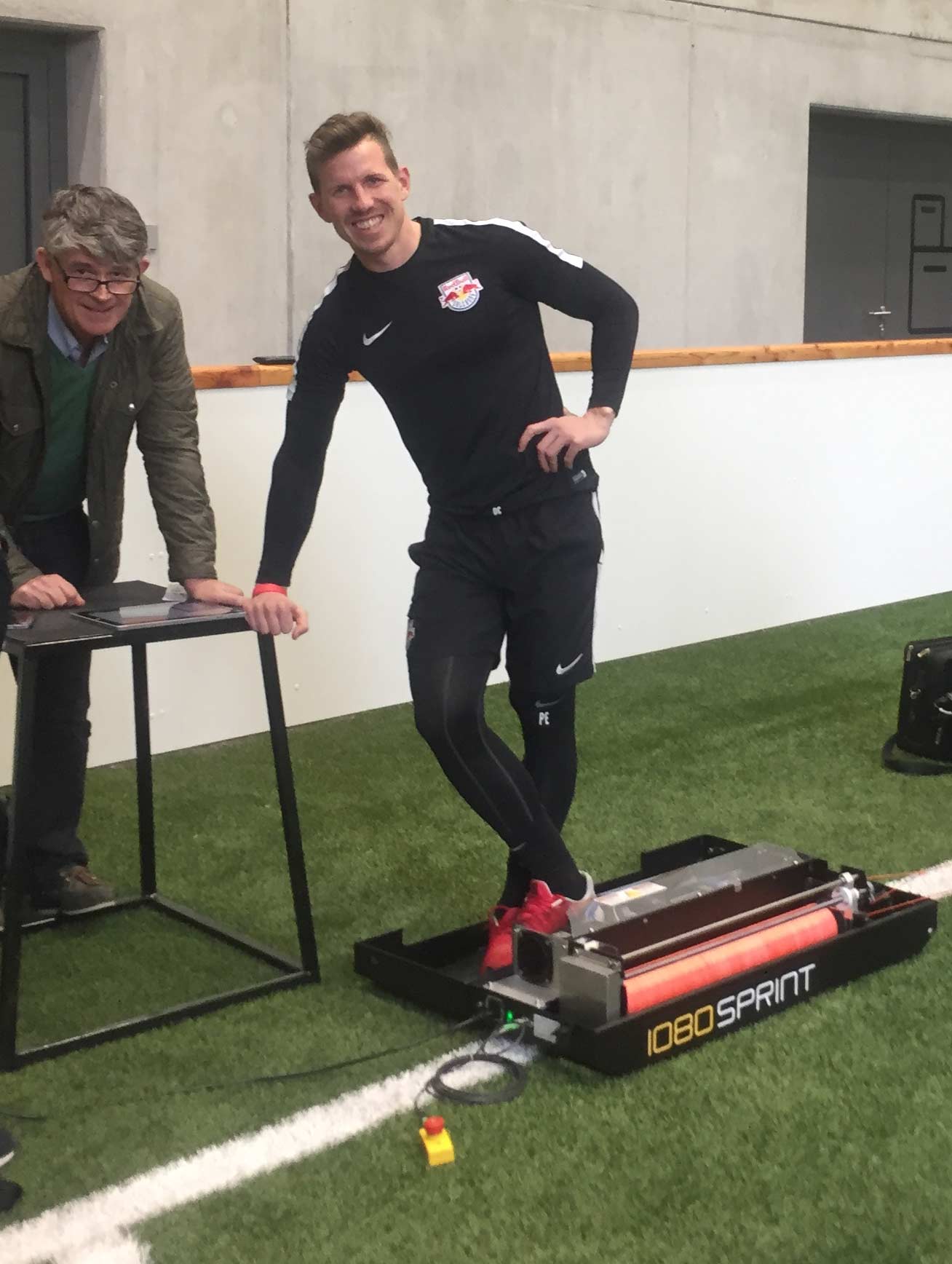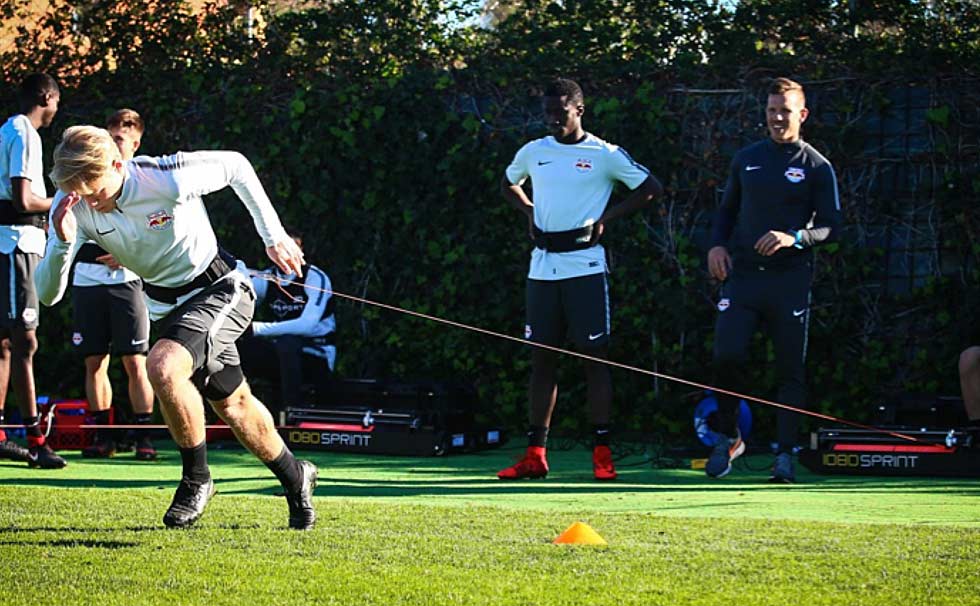Competing in the top tier of German football (soccer), Borussia Mönchengladbach play a season that begins at the end of one summer and concludes on the cusp of the next, with the regular demands of their league fixtures multiplied during months where the club is also engaged in UEFA Champions League or UEFA Europa League play. In order to train players for a sport that prioritizes speed amid a season that saps it, the club’s Athletic Coach Patrick Eibenberger relies on the same communication and decision-making skills that the players model on the pitch.
“When you go in for training, the first thing is you must have clear communication with your team,” Eibenberger says. “Which includes on my side the strength and conditioning coaches, physiotherapists, team doctor, each day you talk through the process to determine what is the status of your players.”
Communication begins with an exchange of pertinent information—whether “man on” or “switch” calls on the field, or sharing the key monitoring insights the high performance team works to generate. With Borussia Mönchengladbach, this begins with sifting through each day’s inputs—which can include subjective measures as well as objective data from GPS, heart rate, enzyme tests, and other metrics—and determining how to communicate the most important points to the relevant stakeholders.
[av_button_big label=’More high performance:’ description_pos=’below’ link=’manually, https://1080motion.com/olympic-hockey-training-cory-kennedy/’ link_target=” icon_select=’no’ icon=’ue800′ font=’entypo-fontello’ custom_font=’#ffffff’ color=’theme-color’ custom_bg=’#444444′ color_hover=’theme-color-subtle’ custom_bg_hover=’#444444′ av_uid=’av-154cfr9′]Speed On The Ice: Olympic Training With Cory Kennedy[/av_button_big]
“(After the performance team meeting) I go to our coaching staff, the head coach and his assistants, and then we talk through the day’s training—what is your plan, what are the tactical demands? Do you want to play large-sided or small-sided games? Is it something in-between, like positional games or rondos? Then we try to take the coach’s puzzle and my puzzle and solve it together.”
From the Starting Block to the Pitch
Training each player to get faster—or, at a minimum, providing the right stimulus to maintain their current level of speed—is a significant piece of Eibenberger’s puzzle. As a sport, football still has a reputation for insularity, in which playing the game is viewed as the best training for the game and there can be pushback against too much work that does not reflect the free-flowing, transition-based nature of the sport. To develop his speed training plan, however, Eibenberger, takes inspiration from those who’ve shared valuable information to help guide the fastest on the track: Charlie Francis, Stuart McMillan, and JB Morin.
“Acceleration is pretty much always acceleration, so the underlying biomechanics behind it are the same,” Eibenberger says. “You need to focus on your knee drive and that you really push the ground hard away, and that you are putting force in the right direction, more horizontally. I also implement the horizontal vector theory, that you relate it back to your strength training so you are addressing the right force vector at the same time.”

Eibenberger began his coaching career in Ghana with the Red Bull organization, developing players he calls “the blueprint of fast, explosive athletes.” Starting from that blueprint, Eibenberger has added foundations from Jonas Dodoo, ALTIS’s mechanical assessments, and Morin’s research on force-velocity profiling, combining those into a process that’s functional on the pitch.
“For me, it’s all just getting bits and pieces from people that are way smarter than I am,” Eibenberger says. “I like data, I like profiling, I like to have a plan for everything and to measure what I can measure, just to give feedback to my players and also to monitor it myself.”
Player Profiling: Descriptive to Prescriptive
Electronic timing systems and radar guns provide outcome-based markers—How fast did the player cover a given distance? What was their maximum velocity?—but what factors produce those outcomes?
“If you just start out with split times, you have a good descriptive factor and can see, okay this boy’s faster than this boy, and over 30 meters this player is faster than this player… but in the end, you have no idea why,” Eibenberger says. “You can observe, you can see maybe one has better mechanics than the other, but beyond that you don’t know what kind of force he’s expressing.”
Using force-velocity profiles generated from sessions with 1080 Sprint and applying analytical methods inspired by JB Morin, Eibenberger turns his data into a source for specific programming insights.
“With the prescription of this data analysis, you can look at a player and say okay, maybe I should work more on his force. What does that mean? Maybe he needs more resisted sprints to work on that part of the curve. Or maybe he has good force, but he’s slow, so I try to train with him more on the max speed side, on the velocity side of the force velocity curve,” Eibenberger says. “So you can individualize the program for each player. When we do sprint training it becomes rather straightforward—you just know this player goes in the force direction, this player goes in the velocity direction of training. Then you set up your groups and you’re good to go.”
“Ghost Monitoring”
“If we really want to know what speed or what resistance a player needs, we would try to find out the P-max or P-optimum of his training,” Eibenberger says. “Specifically with the 1080 Sprint, we would also use a pretty normal training session—some resisted runs in incremental, stepwise tests. You would start out with very low-to-non-resistance, and just increase the load and the resistance each run they do—after four to five runs you would have a very good linear determination of his power and velocity. With some different equations, you could find out what is the optimal load for this individual. At what point does he create the most power?”
For resisted runs, the optimal power load is often 50% of the athlete’s max velocity over a set distance. Individualizing the resistance for each athlete with this measure, Eibenberger largely focuses on what the performance team considers “special strength” training, with 20 meter accelerations that serve as both a speed stimulus and a monitoring input.
“We can use it as a testing tool, where the test is training and training is a test, and we can give them feedback on whether the numbers are going in the right direction,” Eibenberger says. “We can do testing without the boys even knowing it’s testing, and we can just fine-tune the training program invisibly. So it’s more like we are putting ghost monitoring on them. They don’t even know what’s happening, they just train. They focus on their runs and you’re in the background fine-tuning their training, so you can go back and tell them you did well, now we have to increase load or now we need to do it a little differently.”
[av_button_big label=’Next post:’ description_pos=’below’ link=’manually, https://1080motion.com/improving-speed-high-school-athletes/’ link_target=” icon_select=’no’ icon=’ue800′ font=’entypo-fontello’ custom_font=’#ffffff’ color=’theme-color’ custom_bg=’#444444′ color_hover=’theme-color-subtle’ custom_bg_hover=’#444444′ av_uid=’av-pu1hkj’]Improving Sprint Speed In High School Athletes[/av_button_big]
At that point, the critical element returns from decision-making back to communication. Within the club’s performance team, the language is very data driven and specific, but when delivering data-based information to the tactical coaches and players, Eibenberger sees his role as channeling and funneling that information in a way they can easily understand and act on. Creating a clear and direct common language with the players allows Eibenberger to deliver the best plan for each player, each day.
“For a lot of our boys, sprinting off the ball was a rare thing, they didn’t know the approach. But now they like it and they use [1080 Sprint] on a regular basis. It’s not something that’s pre-season or in-season, it’s just part of our training program,” Eibenberger says. “And the 1080 gives us perfect equipment to help us frame our project of getting very fast and becoming athletes who embrace sprinting. Which can be rare among football players and coaches, there are still some coaches who are afraid of this protocol and think sprinting is something bad in training—but it helps.”






























































